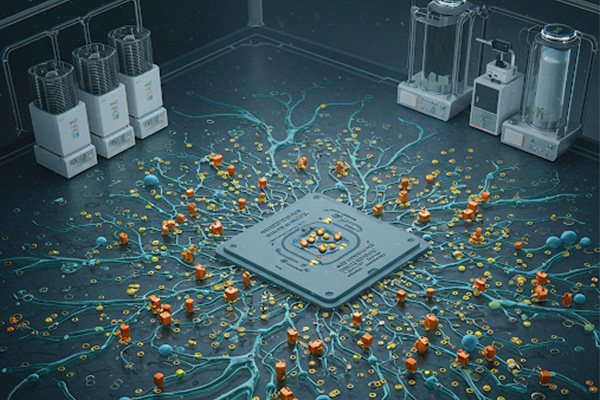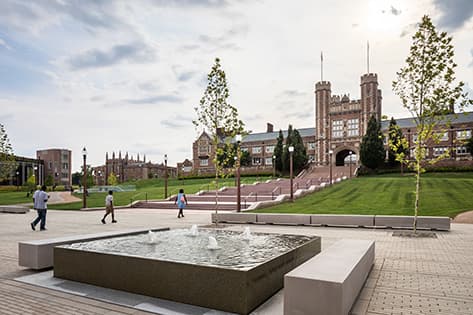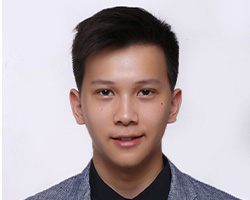A neuro-quantum leap in finding optimal solutions
Shantanu Chakrabartty’s team has developed a problem-solving architecture modeled on neurobiology that leverages quantum mechanical behavior to guarantee optimal solutions to complex problems

It’s easy to solve a 3x3 Rubik’s cube, says Shantanu Chakrabartty, the Clifford W. Murphy Professor and vice dean for research and graduate education in the McKelvey School of Engineering at Washington University in St. Louis. Just learn and memorize the steps then execute them to arrive at the solution. Computers are already good at this kind of procedural problem solving. Now, Chakrabartty and his collaborators have developed a tool that can go beyond procedure to discover new solutions to complex optimization problems in logistics to drug discovery.
Chakrabartty and his collaborators introduced NeuroSA, a problem-solving neuromorphic architecture modeled on how human neurobiology functions but that leverages quantum mechanical behavior to find optimal solutions – guaranteed – and find those solutions more reliably than state-of-the-art methods. The multi-university collaborative effort, which was published March 31 in Nature Communications, originated at the Telluride Neuromorphic and Cognition Engineering workshop and was led by Chakrabartty and first author Zihao Chen, a graduate student in the Preston M. Green Department of Electrical and Systems Engineering in McKelvey Engineering.
“We’re looking for ways to solve problems better than computers modeled on human learning have done before,” Chakrabartty said. “NeuroSA is designed to solve the ‘discovery’ problem, the hardest problem in machine learning, where the goal is to discover new and unknown solutions.”
In optimization, annealing is a process for exploring different possible solutions before eventually settling on the best solution. Fowler-Nordheim (FN) annealers use principles of quantum mechanical tunneling to search for that best, optimal solution efficiently, and they’re the “secret ingredient” in NeuroSA, Chakrabartty says.
“In optimization problems, strategy comes into play when the system needs to shift – like when you’re looking for the tallest building on campus, when do you move to another area?” Chakrabartty said. “NeuroSA’s structure is neuromorphic, like our brain structure with neurons and synapses, but its search behavior is determined by the FN annealer. That critical bridge between neuro and quantum is what makes NeuroSA so powerful and what allows us to guarantee we’ll find a solution if given enough time.”
That guarantee becomes especially important when the timeline for letting NeuroSA search for an optimal solution could range from days to weeks, or even longer depending on the complexity of the problem. In the paper, Chakrabartty’s team, in collaboration with a research team at SpiNNcloud Systems, has already demonstrated that NeuroSA can be implemented on the SpiNNaker2 neuromorphic computing platform, proving its practical feasibility. Next, Chakrabartty anticipates the tool might be applied to optimizing logistics in supply chains, manufacturing and transportation services or to discovering new drugs by exploring optimal protein folding and molecular configurations.
Chen Z, Xiao Z, Akl M, Leugring J, Olajide O, Malik A, Dennler N, Harper C, Bose S, Gonzalez HA, Samaali M, Liu G, Eshraghian J, Pignari R, Urgese G, Andreou AG, Shankar S, Mayr C, Cauwenberghs G, Chakrabartty S. ON-OFF neuromorphic ISING machines using Fowler-Nordheim annealers. Nature Communications, published online March 31, 2025. DOI: https://www.nature.com/articles/s41467-025-58231-5
This work was supported in part by the U.S. National Science Foundation (ECCS:2332166 and FET:2208770), the Federal Ministry of Education and Research of Germany in the program, the EIC Transition under the “SpiNNode” project, the Horizon Europe project “PRIMI", the Italian National Recovery and Resilience Plan (NRRP), the U.S. Department of Energy’s Office of Science, the Office of Energy Efficiency and Renewable Energy's Advanced Manufacturing and Materials Technology Office and SLAC National Laboratory.
SpiNNaker2 is a neuromorphic hardware accelerator platform by SpiNNcloud Systems, a commercial entity with whom some coauthors have affiliations and financial interests. The patents and intellectual property rights for the Fowler-Nordheim based dynamical systems are managed by Washington University in St. Louis.





